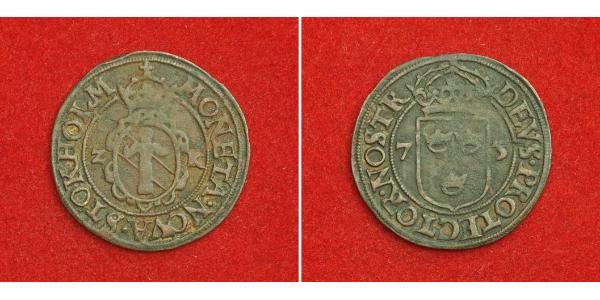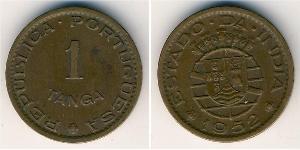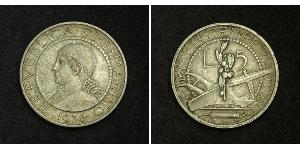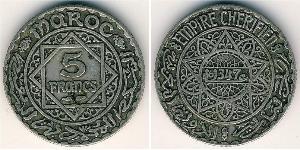(Vendida por $17.0)
1573, Sweden, John III. Scarce Billon 2 Öre Coin. Stockholm mint!
Condition: VF+
Mint Year: 1573
Denomination: 2 Öre
Mint Place: Stockholm
Reference: Hobson 53, S.M.65b.
Material: Billon (bronze & low grade silver alloy)
Diameter: 24.7mm
Weight: 2.75gm
Obverse: Crowned coat oval arms of the House of Vasa within decorative frame, splitting value (2-R).
Reverse: Crowned arms of the Kindom of Sweden (three crowns), splitting date ([15]7-3).
The House of Vasa (Swedish: Vasaätten, Polish: Waza, Lithuanian: Vazos) was the Royal House of Sweden 1523-1654 and of Poland and Lithuania 1587-1668. In 1611-1613 Duke Charles Philip, Prince of Sweden, was a pretender to Russian throne during Time of Troubles; so was Wladyslaw, the future King of Poland, in 1610-1613 (held a powerless title till 1634). Vasa origined from a noble family in Uppland of which several members had high offices during the 15th century. The name continues to be associated with the Swedish royalty.
John III (Swedish: Johan III, Finnish: Juhana III) (20 December 1537 – 17 November 1592) was King of Sweden from 1568 until his death. He was the son of King Gustav I of Sweden and his second wife Margaret Leijonhufvud. He was also, quite autonomously, the ruler of Finland, as Duke John from 1556 to 1563. In 1581 he assumed also the title Grand Prince of Finland.
He was the second son of Gustav Vasa (1523–60). His mother was Margareta Leijonhufvud (1514–51), a Swedish noblewoman. As a Duke of Finland, he opposed his half-brother Eric XIV of Sweden (1560–68) and was imprisoned in 1563. After his release from prison, probably because of his brother's insanity (see Sture Murders), John again joined the opposition, deposed Eric and made himself the king. His important ally was his maternal uncle Sten Leijonhufvud, who at deathbed was made Count of Raseborg. Shortly after this John executed his brother's most trusted counsellor, Jöran Persson, whom he held largely responsible for his harsh treatment while in prison.
John further initiated peace talks with Denmark and Lübeck to end the Scandinavian Seven Years' War, but rejected the resulting Treaties of Roskilde (1568) where his envoys had accepted far-reaching Danish demands. After two more years of fighting, this war was concluded without many Swedish concessions in the Treaty of Stettin (1570). During the following years he successfully fought Russia in the Livonian War, concluded by the Treaty of Plussa in 1583, a war that meant a Swedish reconquest of Narva. As a whole his foreign policy was affected by his connection to Poland of which country his son Sigismund III Vasa was made king in 1587.
In domestic politics John showed clear Catholic sympathies, inspired by his Polish queen, a fact that created frictions to the Swedish clergy and nobility. He launched the Red Book, which reintroduced several Catholic customs. In 1575, he gave his permission for the remaining Catholic convents in Sweden to start receiving novices again. From time to time he was also at odds with his younger brother Duke Charles of Sudermannia (afterwards Charles IX of Sweden). John III was an eager patron of art and architecture.
In January of 1569, John was recognized as king by the same riksdag that forced Eric XIV off the throne. But this recognition was not without influence from John; Duke Karl received confirmation on his dukedom without the restrictions of his power that the Arboga articles imposed. The nobilities' power and rights were extended and their responsibilities lessened.
John was still concerned about his position as king as long as Eric was alive. The fear of a possible liberation of the locked up king worried him to the point that in 1571 he ordered the guards to, in any suspicion of liberation attempt, murder the captured king. It is possible this is how his life ended in 1577.
John III was reported like his father in propaganda, with repeated claims to have "liberated Sweden" from the "bloodhound" Christian II, as well as rescuing the population from the "tyrant" Eric XIV; also violent, hot tempered and greatly suspicious.

3 Kopek Unión Soviética (1922 - 1991) Bronce
grupo tiene 20 monedas / 4 precios
Add coin to this group
2 Stuiver Países Bajos Plata
grupo tiene 33 monedas / 33 precios
⇑
990 coins were uploaded from 2025-05-21 to 2025-05-28
Una de ellas es:























